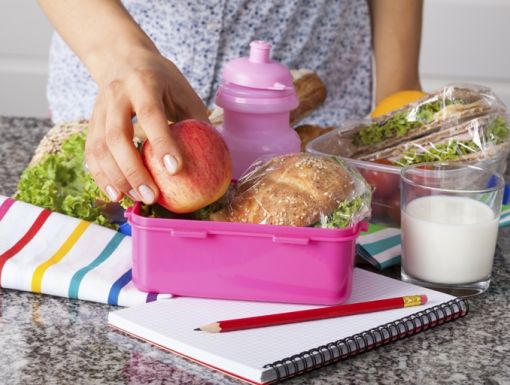
How to Talk About Healthy Food and Healthy Weight with Your Children
Many of us have experienced our children overeating, snacking between meals and choosing foods that are not in the five recommended food groups: fruit, vegetables, lean proteins, whole grains and dairy and opting for sugar-packed snacks instead. This seems to be an issue that permeates our society but is specifically concerning in the pediatric population, when adult eating habits are formed. As parents, we want nothing more than for our children to be happy and healthy, but sometimes this can be difficult. When eating habits lead to obesity, diabetes or cardiovascular conditions, we raise the red flag. However, if we act early, we can prevent this from happening. But how do we talk to our children about healthy eating and living a healthy lifestyle without causing shame, self-doubt or creating a poor body image?
Red Light, Green Light, Yellow Light
One technique that is effective with children is the “red light, green light, yellow light” approach. This technique allows children to identify food choices that should be mostly avoided or consumed in moderation, foods that are healthy and foods that have some nutritional value.
Green-light foods have the highest levels of nutrition. These foods can be eaten at any time and provide your body with the most fuel.
- Lean proteins
- Fruits and vegetables
- Dairy
- Whole grains, such as whole grain bread, oats and fiber-rich grains like quinoa and brown rice
Yellow-light foods have some nutrition, but not as much as green-light foods do. They tend to have more fat, added sugars and calories than the green-light options. Yellow-light foods should be enjoyed on occasion.
- Peanut butter
- Trail mix
- Granola bars
- Cheese sticks
- Ice cream and yogurt
Red-light foods have the lowest nutritional value for your brain and body. These food choices usually contain high levels of sugar and fats and should be replaced with food choices from green and yellow-light options. Red-light foods are considered foods you should avoid due to allergies, specific dietary needs or because of a health condition, such as diabetes.
- Frozen, processed foods
- High-fat and high-salt foods like potato chips, pre-packaged popcorn and pastries
- Sugary beverages like soda and juice
How do we talk to our kids about choosing healthy eating?
When discussing eating choices with your children, it is important to focus on the importance of eating a balanced diet that incorporates the different food groups. A discussion on what role various foods play to provide energy for your body and their specific benefits will allow them to understand the reasoning behind the food choices.
For example: Why do we have to eat vegetables? Well, because vegetables contain nutrients and fiber that our bodies need to grow healthy and strong.
How can kids get involved?
Allow children to become involved in their meal planning by allowing them to choose food items at the grocery store and help with preparing meals. A shift away from focusing on the number on the scale and instead on how healthy our bodies are based on what we decide to put in them is a positive approach to establishing lifelong healthy habits in children without reducing their food choices to how they will affect their appearance. If your child has an athletic role model they look up to, point out what fuel athletes need every day to perform at that level and emphasize that healthy eating isn’t to look a certain way, but to feel and perform at our body’s peak capacity.
Be realistic
An all-or-nothing approach is not helpful with children when attempting to change their lifestyle. Allowing snacks that are in the yellow-light food groups is OK as snacks can be presented as an added fuel source between meals. It is important not to use snacks or treats as part of a reward system, however. Children will then learn that food is a way to comfort or “treat” themselves at stressful times in their lives, which can cause issues later in life, such as disordered eating. Once a good eating pattern is established, an occasional night out to dinner for a special occasion or slice of birthday cake is perfectly fine. The goal is balance, not perfection.
Be a role model
Another important piece is having parents who model healthy eating and lifestyles to their children. Children watch everything we do. If we chose healthy options at our meals, incorporate exercise into our days and work toward a healthy goal, our kids are more likely to model that behavior. It is critical to establish these patterns when they are young, as behavioral change is harder in adults. Model healthy self-talk and avoid negative self-talk and body-shaming. Instead of focusing on how you look in the mirror, focus on how you feel. Your kid will follow suit.
For example: Say things like, “I feel so powerful today,” or, “You look so strong today.”
Celebrate difference
Celebrate body differences, shapes and characteristics that make each person unique. Build your child’s self-esteem by reinforcing how strong, fast and healthy they are. Help them feel in control by having healthy options for them to choose to eat. Create an open dialogue surrounding food and health concerns so that it is not an issue that becomes unspoken within your home. The goal is not to stop talking about food and health, the goal is to reframe those conversations, so they have a positive impact on your child and not the opposite.
It’s not always easy to navigate conversations around healthy eating with children, but with a few simple changes and consistency, small steps can be made in the right direction towards health. Shame not included.
Learn more about Kristy Sullivan, APRN, PMHNP-C here.



